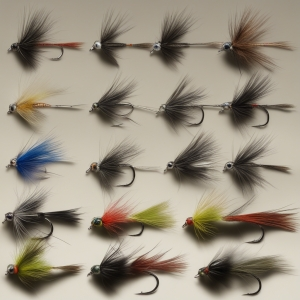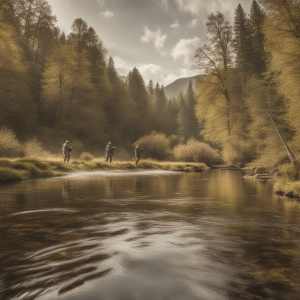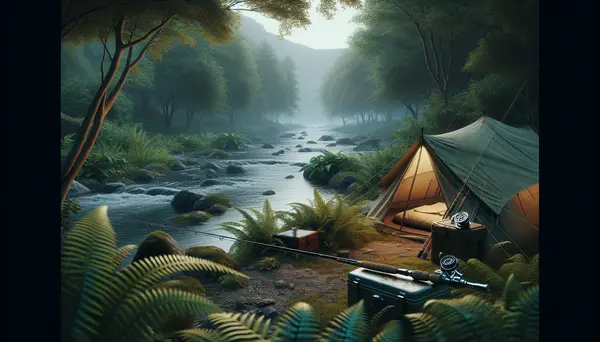Table of Contents:
Years ago, the art of fly fishing was a closely guarded secret, passed down from generation to generation in a handful of families. Today, it's a widely enjoyed sport, accessible to anyone with a love for the great outdoors and a bit of patience. Dive in with us into the fascinating world of fly fishing in this comprehensive beginner's guide. Whether you're a complete novice or you've dabbled a little in the past, this guide is designed to help you get started.
Introduction to Fly Fishing
Fly fishing is a unique style of angling that's been around for centuries. It involves an artificial 'fly' designed to imitate real fish food, catching the attention of fish as it's cast into the water. Traditionally, fly fishing has been associated with game fishing and catching species like trout and salmon. However, it's a versatile technique that can be used to catch a wide range of fish.
If you're used to the standard rod-and-reel approach, fly fishing will offer a more hands-on, interactive experience. The feeling of casting a fly rod, the precision it requires, gives it a sense of artistry that's unique to this approach. But don't be intimidated - with some guidance and practice, anyone can master this rewarding style of fishing.
Beyond the technique itself, fly fishing often brings you closer to nature. Many enthusiasts tout the therapeutic effects of spending time in the great outdoors, amidst tranquil bodies of water. It's not just about landing the big one, it's about the total experience - the journey counts as much as the destination.
Understanding the Basics
The first step in fly fishing is understanding the equipment. The fly rod and reel are specially designed to cast the lightweight fly and manage line during the fishing process. Fly lines are thicker and heavier than typical fishing lines, which aids in casting. Attached to the fly line is a tapered leader, which helps moderate the transfer of energy from the cast and guides the fly to its intended landing spot. The fly itself is a small, handmade imitation of an insect.
Proper casting technique is crucial in fly fishing. Unlike traditional fishing where the weight of the lure carries the line out into the water, in fly fishing, it's the weight of the line that carries the fly. The art of casting involves flicking the rod back and forth in a rhythmic motion, known as the 'backcast' and the 'forward cast'.
Choosing the right fly is also part of the game. Flies come in many forms, representing various types of insect larvae, adult insects, or even small fish. The trick is to match the fly with what the fish are consuming at that time.
Lastly, location plays a significant role too. Depending on the species you wish to catch, you'll need to opt for different types of water bodies, from swift rivers to calm lakes.
Fly Fishing: Pros and Cons
| Pros | Cons |
|---|---|
| 1. Serves as a great stress reliever due to its therapeutic nature. | 1. Requires patience and practice to learn and be proficient at. |
| 2. Provides an opportunity to enjoy and appreciate nature. | 2. Equipment can be expensive for beginners. |
| 3. Offers a challenging and rewarding experience. | 3. Weather conditions can affect the success of fishing greatly. |
| 4. Allows for selective fishing—catch and release. | 4. Hidden hazards need to be considered, such as unknown depth, slippery surfaces, and even wild animals. |
Getting the Right Gear

If you're just dipping your toes into fly fishing, it's crucial to gear up beforehand. The right tools can make the difference between frustration and a thrilling catch. For starters, you will need a quality fly rod and reel combo. The size of the rod largely depends on the type of fish you're aiming for and the conditions in which you'll be fishing.
The choice of fishing line is pivotal. Generally, a weight-forward fly line is recommended for beginners. As the name suggests, its weight is located in the front, which makes it easier to cast.
Naturally, you will also need flies. As a beginner, consider getting a varied assortment of flies to experiment with. These may include dry flies, nymphs, and streamers which mimic different stages of insect life.
Besides these essentials, you must also equip yourself with fishing accessories. A fishing vest with numerous pockets can be very useful. You may also want to invest in a pair of waders to keep you dry as you tread through water. Don't forget a fishing hat for sun protection and polarized sunglasses to cut glare and more easily spot fish under water.
Carrying a guide book or having a fishing app handy can be beneficial as well, especially for identifying different species and their behaviors. Remember that the right gear not only equips you for success but also ensures safety and comfort during your fly fishing adventures.
Perfecting Your Casting Technique
The perfect casting technique can take time and practice to master, but it's crucial for successful fly fishing. Here are a few key steps and tips to understand and perfect your casting game:
Getting the right grip is the starting point. Your hand should wrap around the rod handle with your thumb on top, pointing towards the rod tip. This thumb-on-top grip will give you better control and accuracy.
The basic fly cast consists of two key movements: the backcast and the forward cast. During the backcast, you swiftly lift the rod, causing the line to follow. Once the line is fully extended behind you, that's when the forward cast comes in. Here, you smoothly accelerate the rod forward to cast the line out into the water.
Timing is a significant aspect. Allow for brief pauses in each cast. This lets the line properly extend in the air before you go into the next movement. Too quick or premature movements can end up tangling the line or causing the fly to snap back.
Practice makes perfect, and it's no different with casting. You don't necessarily have to be near water to practice casting. Your backyard or any open space can serve as a training field. Start with shorter casts and gradually work your way up as you become more confident with your movements.
Rod flexibility, or action, also influences your casting. As a beginner, a medium action rod might be more suitable as they provide a good balance for both casting and fish fighting.
Lastly, don't be too hard on yourself. Even the most seasoned fly fisherman can find themselves struggling with the perfect cast from time to time. Be patient, stay focused, and enjoy the learning process!
Choosing Your Fly

Another essential aspect of fly fishing is selecting the right fly. The fly you choose should mirror the aquatic or terrestrial insects that the fish are feeding on in the area you're fishing at that specific time. Meaning, you're imitating the prey insects of fish, luring them to your bait.
Flies come in a myriad of shapes, sizes, and colors, typically representing insects at various life stages, from larvae to fully-fledged adults. They're generally classified into three main types: Dry Flies, Nymphs and Streamers.
Dry flies float on top of the water surface and mimic adult insects. These are ideal in situations where fish are actively feeding on the surface.
Nymphs represent the juvenile stage of aquatic insects. They sink below the water surface and are best suited when fish are feeding underwater, which actually, is most of the time.
Streamers are a little different. Instead of insects, they imitate baitfish or larger aquatic creatures. They're bigger than dry flies and nymphs and are particularly effective for predatory fish species.
As a beginner, you might find it a bit overwhelmed with the vast variety of flies. But don't worry. Start with some basic assortment. With time, observation, and experience, you'll soon be able to choose your fly like a pro.
Remember, the aim is to 'match the hatch', that is, using a fly that matches the insects the fish are currently feeding on. This might require switching flies during the day as hatches can change.
The Importance of Patience and Practice
While fly fishing might appear deceptively simple to the uninitiated, it's actually an activity that demands a high degree of patience and practice. Learning to cast accurately, understanding how to select the right fly, and developing an aptitude for reading water conditions, all come with time and consistent effort.
Accomplished anglers will attest that patience is one of the key virtues in fly fishing (and in angling in general). Remember, it's not just about making the catch; it's about being present and being intimate with nature. Fly fishing offers a meditative experience that can be as rewarding as the thrill of reeling in a big catch.
Even as you become more adept at fly fishing, every outing presents an opportunity for further practice. Rain or shine, every day on the water can hold a unique lesson. The unpredictable nature of weather patterns and fish behavior indicate that there's always something new to learn in this beautiful sport.
Embrace the journey, keep honing your skills, and remember that the joys of fly fishing often lie beyond the catch itself. Don't get discouraged if progress seems slow; great achievements in fly fishing are the result of steady dedication. Accept the learning process as an integral part of the experience, because every cast brings you one step closer to becoming an expert fly fisher.
Conclusion

The world of fly fishing is as rewarding as it is intriguing. It's an immersive, interactive way to enjoy the great outdoors while pursuing an age-old pastime. Equipped with the right gear and knowledge, a journey into fly fishing can open up a whole new world of thrilling adventures. Be patient with yourself and remember that the most crucial part of this sport is to enjoy the process. With time, you will master the casting techniques and develop an intuitive sense of which flies to use under different circumstances. In the end, fly fishing tends to become less of a hobby and more of a life-long passion. Jump in, start casting, and let the mesmerizing world of fly fishing unfold in front of your eyes.
Beginners Guide to Fly Fishing
What is fly fishing?
Fly fishing is a type of angling method that uses an artificial 'fly' to catch fish. The fly is cast using a fly rod, reel, and specialized weighted line.
How do you get started in fly fishing?
Getting started in fly fishing involves learning about the types of gear, the species of fish, and the different fly fishing techniques. It's also essential to practice casting.
What equipment do I need for fly fishing?
The basic equipment needed for fly fishing includes a fly rod and reel, fly line, leaders, tippets, flies, and accessories like line clippers, fly boxes, and vests.
What types of fish can I catch with fly fishing?
You can catch various species with fly fishing, including trout, salmon, bass, pike, and carp. Different species require different fly fishing techniques.
What are the benefits of fly fishing?
Fly fishing provides many benefits, including stress relief, connection with nature, physical exercise, and the pleasure of learning a challenging and fulfilling pastime.







